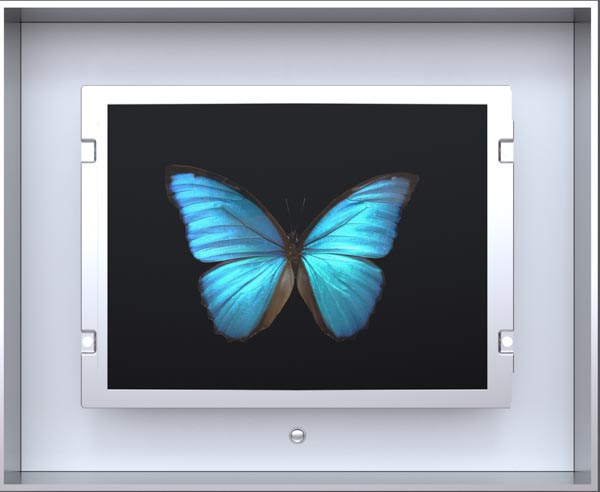 ⤣ SERIES
⤣ SERIESFlutter
Flutter is an interactive piece that explores the viewer’s encounter with a virtual butterfly in flight. The sequenced form of the installation refers to the early examples of animated movement first developed in the zoetrope, and its successor, the praxinoscope. However, unlike the linear time-sliced nature of these contraptions, the introduction of interactive control in Flutter enhances the lifelike ephemerality of the encounter to influence the viewer’s engagement with the piece. Set within a striking architectural framework and employing advanced technologies, the artwork is a product of Harris’s ongoing fascination with the motion of a butterfly’s flight and the iridescent reflections created by the scales on the insect’s wings.
The Collection
Images
Information
Year:
2011
Edition:
Edition of 8 + 2 Artist Proofs + 2 Museum Proofs
Materials:
Code, electronics, sensors, computer, mirror, metal, screens
Details:
Dimensions (Metric):
56 screen version:
302 x 38 x 12 cm
88 screen version:
480 x 38 x 12 cm
(W x H x D)
Dimensions (imperial):
56 screen version:
118.7 x 15 x 4.6 inches
88 screen version:
189.1 x 15 x 4.6 inches
(W x H x D)
Commissioned by:
Context
"Fascination with the butterfly is not a recent phenomenon in the art world. From Vincent van Gogh to Salvador Dalí, the butterfly has presented itself as a timeless kindred spirit, offering a variety of interpretations many of which have had a long-standing presence in popular culture, film and literature, as well as art. With their enormous palette of colours, as well as their fragility and variety, butterflies have often been used to symbolise aspects of human nature. The wide range of interpretations is as far-reaching as the many species of butterfly found across the world. One of the more compelling in art history has been the representation of humanity’s capability for transformation. Contemporary artists of different mediums have grasped this historical precedence and upheld the numerous symbolic references, so that the butterfly has come to signify a ubiquitous theme: the duality of life and death. Dominic Harris has built upon these foundations by using the butterfly not only as an art piece, but also as a design object. The viewer is in the direct gaze of Harris’ interpretation as well as the butterfly’s natural creative spirit, allowing new discourses between the audience, the artist and these colourful insects to take shape."
Extract from essay by Harman Bains


%20-%201920x1080.webp)




_01---1090x1920.webp)

---STATIC---1920x1080-opt.webp)





%20by%20Dominic%20Harris_01_33_Grid%20of%20Nine-medium.webp)
